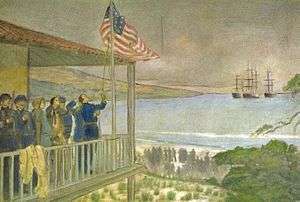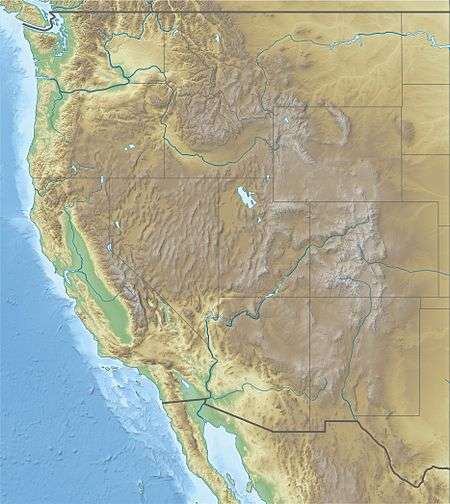Battle of Monterey
The Battle of Monterey, at Monterey, California, occurred on 7 July 1846, during the Mexican–American War. The United States captured the town unopposed.
| Battle of Monterey | |||||||
|---|---|---|---|---|---|---|---|
| Part of the Mexican–American War | |||||||
 Officers of Commodore Sloat raise the U.S. flag over Monterey | |||||||
| |||||||
| Belligerents | |||||||
|
|
| ||||||
| Commanders and leaders | |||||||
| John D. Sloat | Mariano Silva | ||||||
| Strength | |||||||
| 225 sailors and marines[1] | unknown | ||||||
| Casualties and losses | |||||||
| None | None | ||||||
 Location within modern-day United States | |||||||
Prelude
Prior to the Mexican–American War the Californio forces had routed the Mexican-appointed Governor Manuel Micheltorena and most of his forces from Alta California. The Californio Governor Pio Pico, had about 100 poorly armed and poorly equipped soldiers, and was nominally in charge in Alta California; he consolidated his forces in Pueblo de Los Angeles—the then-largest city in California with about 1,500 residents.[1]:176
The main forces available to the United States in California were the about 400–500 bluejacket sailors and U.S. Marines on board the five ships of the Pacific Squadron there. Speculating that war with Mexico over Texas etc. was very possible, the U.S. Navy had sent several additional naval vessels to the Pacific in 1845 and 1846 to protect U.S. interests there and prevent possible British action. It took about 200 days, on average, for ships to travel the over-12,000 miles (19,000 km) trip from the East coast around Cape Horn to get to California. More ships assigned to the Pacific Squadron would continue to arrive from 1846 to 1847.
On 26 May, Commodore Sloat received word of the Battle of Palo Alto and the Battle of Resaca de la Palma, upon which he sent a coded message to Secretary of the Navy George Bancroft that he was leaving for California.[1]:167 Sloat sailed on the frigate Savannah on 8 June, arriving at Monterey on 1 July.[1]:168,170
They joined the sloop USS Cyane which was already there.[2]:205 There were U.S. fears that the British might try to annex California to satisfy British creditors.[2]:180 The British Pacific Station's ships off California were stronger in ships, guns and men.[3]:199
On 6 July, Sloat decided to seize Monterey and San Francisco, wondering if "Captain Freemont will cooperate with us."[1]:170
Battle
Capt. William Mervine of the Cyane came ashore with a small party from the Savannah at 7:30 AM on 7 July, seeking the surrender of the port from the Mexican commandant, Capt. Mariano Silva.[1]:170 Silva replied that he was "not authorized to surrender the place."[1]:170 In fact, Silva was in command of a nonexistent garrison.[1]:170 The Californio soldiers had already left the town's defenses and gone to Los Angeles. They would have had no gunpowder to use in their few cannons even if they had stayed.[2]:205
At 10 a.m., 225 sailors and marines from Sloat's three warships landed.[1]:170[4] They formed before the Customs House where Purser Rodman M. Price read Sloat's proclamation of a state of war between the US and Mexico and the annexation of California by the US.[1]:171 The only shots fired were a 21-gun salute to the new US flag fired by each of the US Navy ships in the harbor.[3]:252 The British ships observed but took no action.
Aftermath
Sloat recognized Mexican real estate titles and church lands.[1]:171 He also established justices of the peace when the alcaldes resigned his office.[1]:171
Capt. John B. Montgomery of the Portsmouth received Sloat's message to seize Yerba Buena (San Francisco) and by 8 AM on 9 July, read the pronouncement at the Customs House.[1]:171 He then replaced the Bear Flag with the American flag.[1]:171 The American flag was run up with a 21-gun salute.[1]:172 Montgomery then sent Purser James H. Watmough to notify Fremont at Sonoma and Sutter's Fort.[1]:171
Commodore Robert F. Stockton arrived at Monterey Bay aboard the Congress on 15 July and took over command from Sloat.[1]:170 The British ship of the line Collingwood arrived in Monterey on 23 July, and Juno arrived at Yerba Buena on 11 July, but neither ship interfered in the American activities.[1]:172
The Bear Flag revolutionaries were soon combined with John C. Frémont's 60 man exploratory force to form the U.S. sponsored California Battalion under the command of Frémont.[1]:173 The California Battalion, which varied from 160 to 400 men, drew regular army wages and were used to garrison and maintain order in the towns that had surrendered.
The Americans held northern California but General Jose Maria Castro and Governor Pio Pico planned resistance in the south.[1]:172
See also
- Battles of the Mexican–American War
References
- Bauer, K.J., 1974, The Mexican War, 1846–1848, New York:Macmillan, ISBN 0803261071
- Cleland, Robert Glass (1922). A history of California: the American period. The Macmillan Company. Retrieved 6 July 2011.
- Bancroft, Hubert Howe; Nemos, William; Victor, Frances Fuller (1886). History of California. History Co. Retrieved 6 July 2011.
- Craig L. Symonds Naval Institute Press, 2001